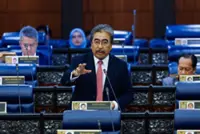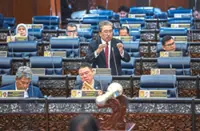A work titled 'Oracles' (automotive paint on aluminium, 2024), featured in Lean’s new exhibition 'Colored' at Wei-Ling Gallery in Kuala Lumpur. Photo: The Star/Glenn Guan
Six larger-than-life “porcelain” works from artist Sean Lean greet you as you step into Wei-Ling Gallery in Kuala Lumpur.
But beyond their size, what stands out is that they’re each cut into three precise sections – either vertically or horizontally – and arranged in such a way that none of the pieces are perfectly aligned.
In his latest triptych series, Colored, the division of the pieces into three parts offer a parallel into Lean’s own process of rebellion, exploration and acceptance of his cultural identity.
These three-panelled artworks have been explored by Lean before in his 2018 series, 3, and in his last solo exhibition china (2022-2023), he made larger versions of real-life Chinese porcelain works.
“I didn’t feel like I exhausted the inspiration for porcelains yet, so you could say that this is kind of a continuation,” says Lean, 43, in a recent interview at the gallery.
This time, however, Lean chose coloured “porcelain” works rather than the iconic blue and white often associated with Ming porcelain.
“The title is a play on words – the series talks about viewing things through ‘coloured lenses’ and all the pieces are coloured porcelain,” he adds.
Transitioning from the traditional blue and white scheme to a broader spectrum of colours posed some difficulty.
“I kind of underestimated the complexity, especially in mixing and blending the colours. There was also a level of refinement that I wanted to achieve, more so compared to the pieces from my previous series, so it took a lot more time,” explains Lean.
His close attention to detail is what makes it difficult to believe that the pieces aren’t actually made from porcelain – automotive paint was applied to aluminium sheets with a clear top coat that’s painstakingly waxed to a shine, creating a “faux-porcelain” effect to complete the illusion.
“It was important for the pieces to not be porcelain, for it to be an illusion. It’s an expression of me feeling like an outsider or an imposter most of the time,” he says.
Use your illusion
Lean, originally from Klang, Selangor, now resides there after spending several years in Petaling Jaya. Additionally, he spent a significant portion of his childhood in Penang, where his paternal grandfather resided.
As the grandson of a first-generation Chinese immigrant from Fujian, China, Lean has always had a complicated relationship with his cultural heritage and familial expectations.
“I went to Chinese school for my primary and secondary education and my parents didn’t really speak English. My dad was very traditional, so my upbringing was one where he tried to instil in me a sense of loyalty to a country that he wasn’t even born in.
“I didn’t really agree with that, so in my teenage years, I rebelled by getting into American pop culture, like listening to grunge music and reading comics,” says Lean.
In the gallery, the conflict between the Chinese customs of his upbringing and the influences of Western culture is mirrored in the central motif of each artwork showcased in Colored, where it is pulled in opposing directions and stretched out.
It was only in his late 20s that Lean began to reconnect with his Chinese cultural roots.
“I’ve always liked Chinese culture, like (the classics) Journey To The West and The Romance Of The Three Kingdoms, but because that Chinese identity was pushed onto me by my family, I turned away from it for some time,” he admits.
“But now through my art, I’m choosing to recreate Chinese historical objects as a way of paying respect to my background, as a kind of homage.”
Out of place
Lean recounts his first trips to Shanghai and Beijing, which were odd experiences for him.
“You’re surrounded by so many people who look like you, but it doesn’t feel like home, it feels so foreign. My image of home is different colours and different languages,” he says.
On the other hand, a trip to Japan also highlighted his feeling of “otherness” while in Malaysia.
“I went to a seaside town, and after getting down from the bus, I saw a bunch of Japanese kids hanging out by the railings at the side of the road, just watching us. They’re not trying to impress anyone, they’re just looking and staring at you.
“That confidence they had, that sense of place and ownership, I don’t have that sense of ownership here, but I think it’s mostly because of the mindset I was raised with. However, my instinct has always been to identify as Malaysian first, Chinese second.”
Due to this, Lean frequently experienced a sense of not belonging entirely, fuelling his quest to discover beauty in every form, regardless of its fragmented or disconnected nature.
“At the beginning of this series, I thought that one of my goals was to find a place where I belong, where I can be comfortable. But now, I’m more interested in looking at where I am now. Like if there was a map in front of me – where do I stand?” he says.
“My works are more about acceptance now, rather than chasing something that maybe I’ll never reach.”
Foreign perspectives
Lean’s quest to understand his identity prompted him to incorporate an extra element into the pieces of this series: excerpts from Western travellers’ observations and perceptions of China, subtly woven into each artwork.
These quotations, selected by Lean, originated from journalists, diplomats, and missionaries like Elijah Coleman Bridgman, Matteo Ricci, G.F. Davidson, George Ernest Morrison, and Sir George Staunton, who engaged in cultural dialogues from the 16th to the 19th centuries.
Though short and succinct, the quotes are a reflection of their time, shedding light on the motivations that shaped foreign perceptions, be it bias, discrimination or admiration.
“For many of the pieces, I took a porcelain piece I liked and found a quote that matched it, but for this quote, I knew I wanted to use it and looked for a piece that would best go with it,” says Lean.
“Most of the quotes I chose are somewhat positive, but this one is probably the most controversial, blatantly racist quote,” he adds, referring a worked titled Yellow, with a G.F. Davidson quote.
For the gallery visitor, encountering a vibrant, aesthetically pleasing artwork juxtaposed with a discordant quote is likely to evoke cognitive dissonance.
However, considering Lean’s intentions, this dissonance is likely deliberate.
Colored is showing at Wei-Ling Gallery in Brickfields, KL until June 1. Exhibition is open by appointment only. Call 03-2260-1106 or email siewboon@weiling-gallery.com.








